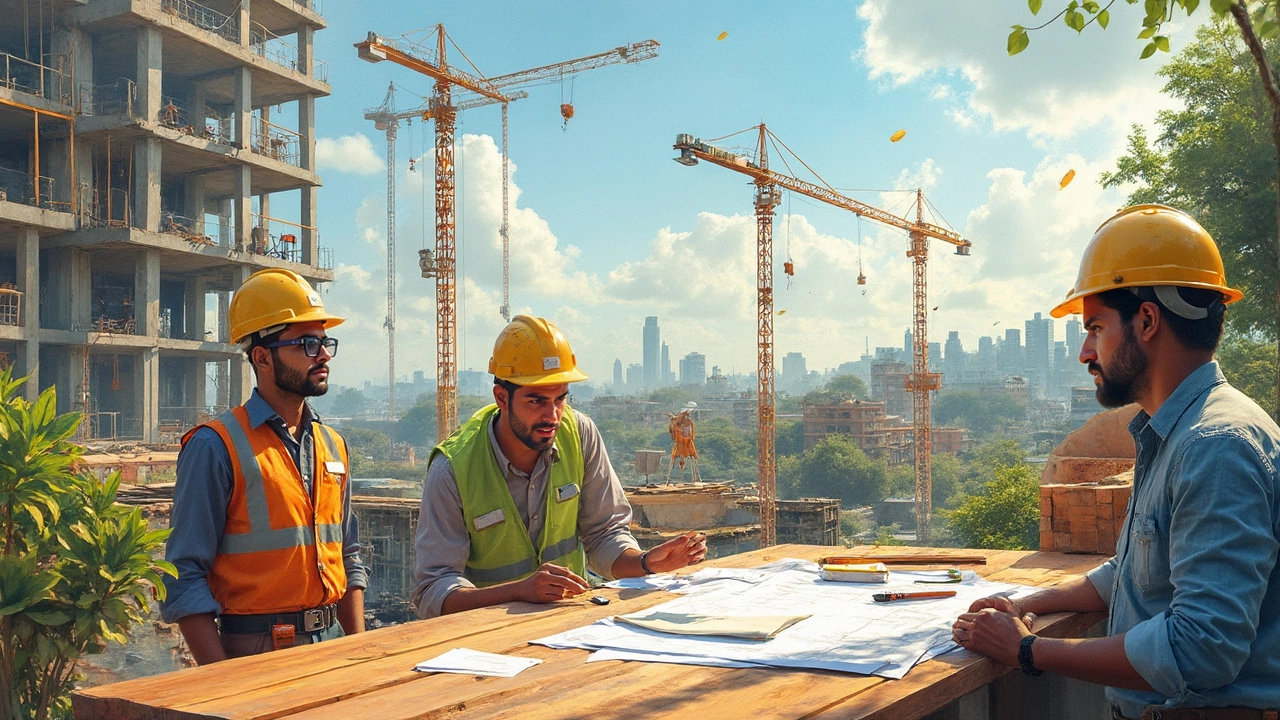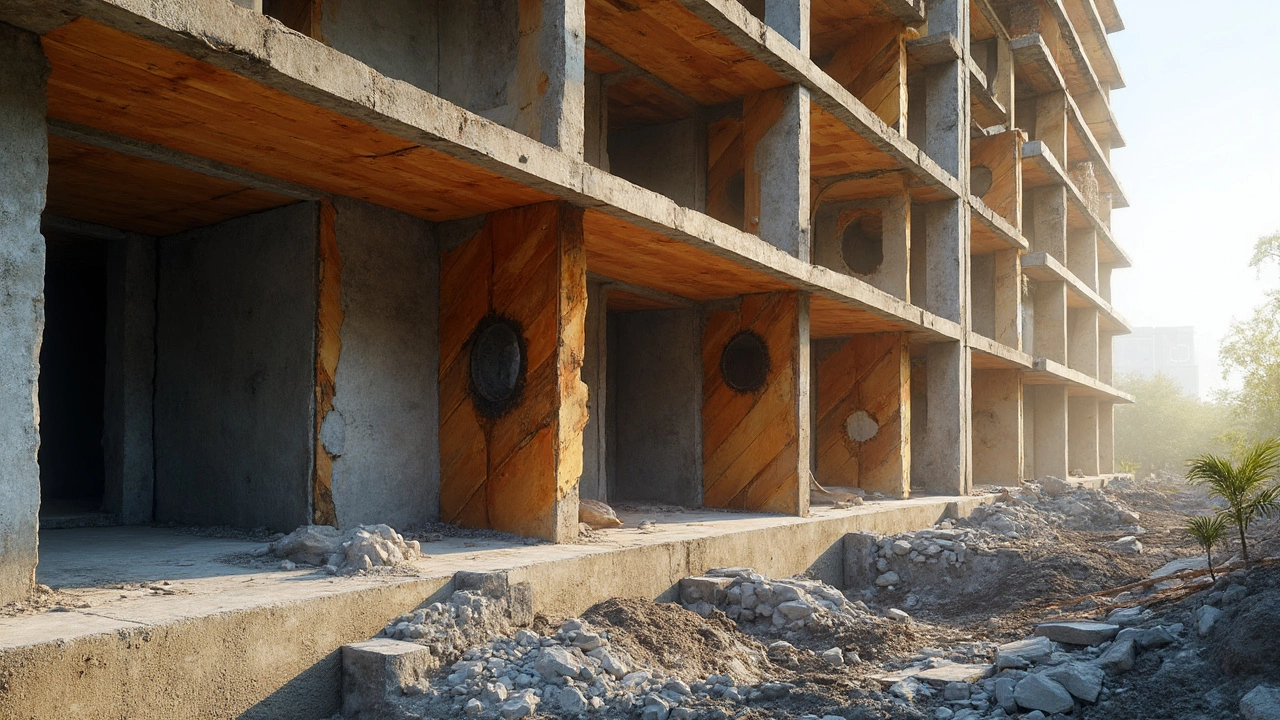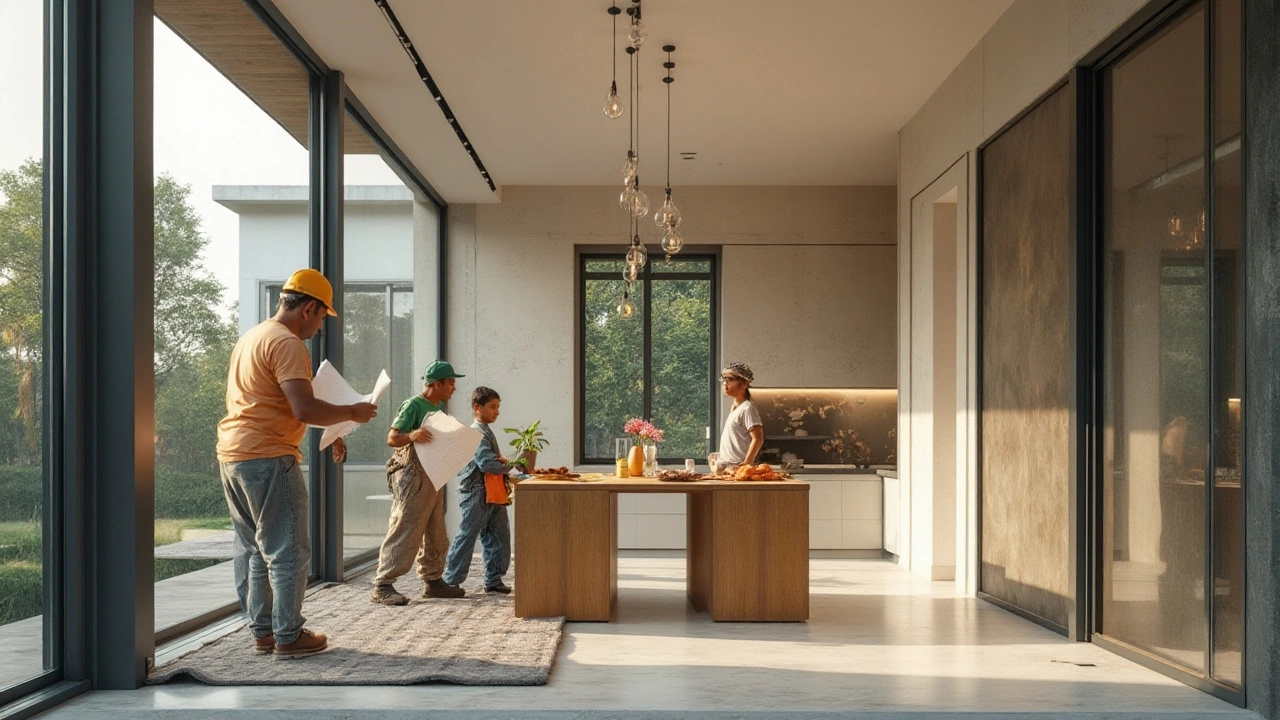What Are Most New Builds Made Of?

If you're wondering what new builds are made of these days, you're in good company. Concrete and steel still hold their ground as the champs in construction for their strength and reliability. You'll probably notice them in your local tall buildings and shopping complexes. They're not going anywhere, anytime soon. But let's not forget, modern construction is evolving.
Yep, eco-friendly options like cross-laminated timber (CLT)—it's not just wood; it's engineered wood—are getting some serious attention. Why, you ask? It's because these add a fantastic blend of sustainability and strength to the mix. Plus, they look pretty snazzy.
Choosing materials is more than just ticking boxes for looks or cost. It's about knowing how long your building will stand tall and proud. Different materials bring varied benefits to the table, like longevity or lower energy costs.
- Core Materials of Modern Construction
- Exploring Alternative and Eco-Friendly Options
- Impact of Material Choice on Durability
- Costs and Benefits of Different Materials
- Future Trends in Construction Materials
Core Materials of Modern Construction
When you're looking at new builds, there's a good chance you'll see a lot of concrete and steel. These are like the bread and butter of modern buildings. Concrete, which started gaining popularity over a century ago, is known for its strength and durability. It's used for everything from foundations to massive skyscrapers.
Why do builders dig concrete so much? Well, for starters, it's weather-resistant and can handle the load without cracking under pressure. That's why you see it used a lot in places with iffy weather. Even in places prone to hurricanes or earthquakes, reinforced concrete structures are often the go-to choice.
Coming to steel, it's the backbone (literally) of most tall buildings. Its strength-to-weight ratio is hard to beat, and it gives architects the freedom to design those eye-catching skyscrapers that reach for the sky. It's flexible enough to bend without breaking, making it ideal for structures that need to stand firm against the natural flexing that occurs at great heights.
Basic but Mighty: Brick and Wood
Of course, we can't leave out the old favorites: brick and wood. While they might seem a bit old-school, these materials still have their place in modern construction. Bricks, for example, are used for their fire resistance and thermal mass, which helps keep temperatures stable inside a building.
And wood isn't just for quaint country homes. Engineered wood products such as cross-laminated timber (CLT) are rising stars in construction. CLT allows for flexibility in design and can even be a more sustainable option compared to traditional materials. It's especially popular in areas looking to push the envelope on eco-friendliness.
Mixing It Up for Better Results
While each material has its unique perks, contemporary builds often mix and match them to achieve the best results. A modern building might use a concrete foundation for strength, steel framing for height, and a wooden facade for aesthetics and sustainability. This combination not only makes the building look good but also ensures performance efficiency over time.
Understanding the different materials that make up modern constructions gives you a deeper appreciation of the planning and know-how involved. Plus, it's super handy information to have if you're thinking of getting involved in the home-building process yourself, whether that's as an investor, a buyer, or just someone looking to stay informed.
Exploring Alternative and Eco-Friendly Options
In recent years, there's been a real buzz around eco-friendly building materials. It's no longer just about concrete and steel. Builders today are looking at ways to reduce the carbon footprint of new builds.
Breaking the Concrete Norm
One growing trend is the use of cross-laminated timber (CLT). It's basically wood layered in different directions, which makes it super strong. Think IKEA furniture but on a whole different level. The great thing about CLT is not just its strength but its sustainability. Trees, after all, can be replanted.
A study from the University of Washington found that timber structures can be up to 74% faster to construct than traditional concrete structures, which means less time—and often less money—spent on building.
"Sustainable building materials are not just a trend—they're the future," says Dr. Lisa Markham from the Green Building Council.
The Straw Bale Revival
Would you believe straw bales are making a comeback in construction? It's not just for the Three Little Pigs. Straw bales offer amazing insulation properties. They are biodegradable, renewable, and can be sourced locally, which cuts down transport emissions.
- Cost-effective: Straw bales are relatively cheap and can also cut down on heating and cooling costs due to their insulation capabilities.
- Fire Resistance: Surprisingly, straw bales are highly resistant to fire because they are so tightly packed, there's little oxygen to burn.
Rammed Earth: A Blast from the Past
Rammed earth is another interesting option. It's an ancient method but with modern tweaks, it's great for building solid walls. Mixing soil, clay, gravel, and sometimes a bit of cement, you get a material that's durable and provides natural insulation.
| Material | Carbon Footprint Reduction |
|---|---|
| Cross-laminated Timber | 50% less than concrete |
| Straw Bales | Almost zero |
| Rammed Earth | 30% less than standard bricks |
These alternative materials are making waves because they don't just save the planet; they often end up saving developers money, too. And as more people realize this, we can only hope to see more buildings tapping into these resources.

Impact of Material Choice on Durability
When you're scouting for materials to use in new builds, durability is king. It's about making sure your investment stands the test of time without constant hiccups. Among the top players in this area is concrete, praised for its reliability and minimal maintenance. It's no wonder so many folks choose this trusty option for both residential and commercial projects. But hold on, it's not the only option on the block.
Steel is another fan favorite, especially for taller structures. It provides outstanding strength-to-weight ratio, making it perfect for skyscrapers that need to pierce the sky without buckling under pressure. Expect your steel-structured building to flex and sway, adapting to stress without cracking—pretty neat, right?
For those considering more sustainable options, there's cross-laminated timber (CLT). Beyond its green credentials, it's durable and surprisingly resistant to fire when compared to regular timber. This toughness makes CLT a solid choice even if you're leaning eco-friendly.
Factors That Affect Durability
- Environmental Conditions: Materials can react differently depending on the location, like humidity wearing away wood faster than expected.
- Construction Quality: Skilled labor ensures materials perform to their full potential. Even the best materials can fail with bad workmanship.
- Maintenance Schedule: Regular check-ups are essential. Spotting issues early, like tiny cracks in concrete, can save a lot of headaches—and money.
According to a 2023 housing report, buildings using concrete as their primary material lasted about 50% longer in coastal regions than those primarily using wood. That's a fact worth considering if you're near the waves.
In the end, every choice, big or small, impacts the durability of your new build. Picking the right materials means fewer repairs down the road and longer-lasting happiness with your choice.
Costs and Benefits of Different Materials
Choosing the right materials for new builds isn't just about following trends. It's about weighing costs against benefits to find the best fit for your project. Let's break it down.
Concrete
Concrete is a go-to for a reason—it's reliable and durable. It’s been around for ages and delivers excellent heat resistance, making it great for keeping your house cool in summer. On the flip side, concrete can be pricey due to the labor and time it takes to set up.
Steel
Steel is often used in commercial builds but is becoming a favorite in homes too. It's incredibly strong yet flexible enough to withstand natural disasters like earthquakes. The downside? Steel structures can be costly, especially if you're factoring in insulation and corrosion prevention.
Timber
Timber, especially eco-friendly options like cross-laminated timber, has been catching attention. It's relatively cheap and needs less energy for production, making it a sustainable choice. But it requires good maintenance to avoid pests and decay.
Cost Comparison
Here’s a quick peek at the typical cost ranges for each material:
| Material | Average Cost per sq ft |
|---|---|
| Concrete | $3 - $5 |
| Steel | $5 - $10 |
| Timber | $2 - $4 |
Remember, these are averages and can vary based on your location and specific project needs.
Making a Decision
If you're building a modest family home, timber might be your friend, providing a cozy feel without breaking the bank. But if you're planning a skyscraper, you'll thank steel and concrete for their sturdiness.
Ultimately, the choice of material depends on what you value more—cost, look, sustainability, or durability. It's worth chatting with a specialist to figure out what's best for you. Armed with this knowledge, you're well on your way to making a smart decision for your next new build.

Future Trends in Construction Materials
The construction world isn't staying still, and there are some pretty exciting changes on the horizon. As more people push for greener construction practices, we're seeing an intriguing variety of construction materials shaking things up. Builders and developers are leaning into materials that promise to be stronger, last longer, and have less impact on our planet.
Biodegradable Materials
First up, biodegradable materials are gaining traction. Made from renewable resources like agricultural by-products, these are great because they break down naturally—meaning less mess for future generations to clean up. Imagine building a house and knowing it won't haunt the planet in a hundred years.
Smart Materials
Then there are smart materials. Think of them like the iPhones of construction. These high-tech options, like self-healing concrete and responsive glass, adapt to their environment. Self-healing concrete can repair its own cracks, reducing maintenance over time. Responsive glass, on the other hand, tints automatically to control sunlight, which can help keep energy costs in check.
3D Printed Structures
3D printing is also making waves. Building homes layer by layer with giant printers? It sounds straight out of a sci-fi movie, but it's real and rapidly growing. This method cuts down on waste and time, making it a potential game-changer in new builds.
Energy-Efficient Materials
Lastly, materials focused on energy efficiency are a huge deal. These could include everything from advanced insulation that keeps houses cozy without cranking up the heater to solar roof tiles that look like regular shingles but pack a punch in energy savings.
The future of new builds looks promising, chock-full of innovative materials that aren't just interesting but also essential in leading construction towards a more sustainable path. As technology and environmental awareness continue to push the boundaries, it's a thrilling time to see what new trends will emerge and redefine what's possible.

